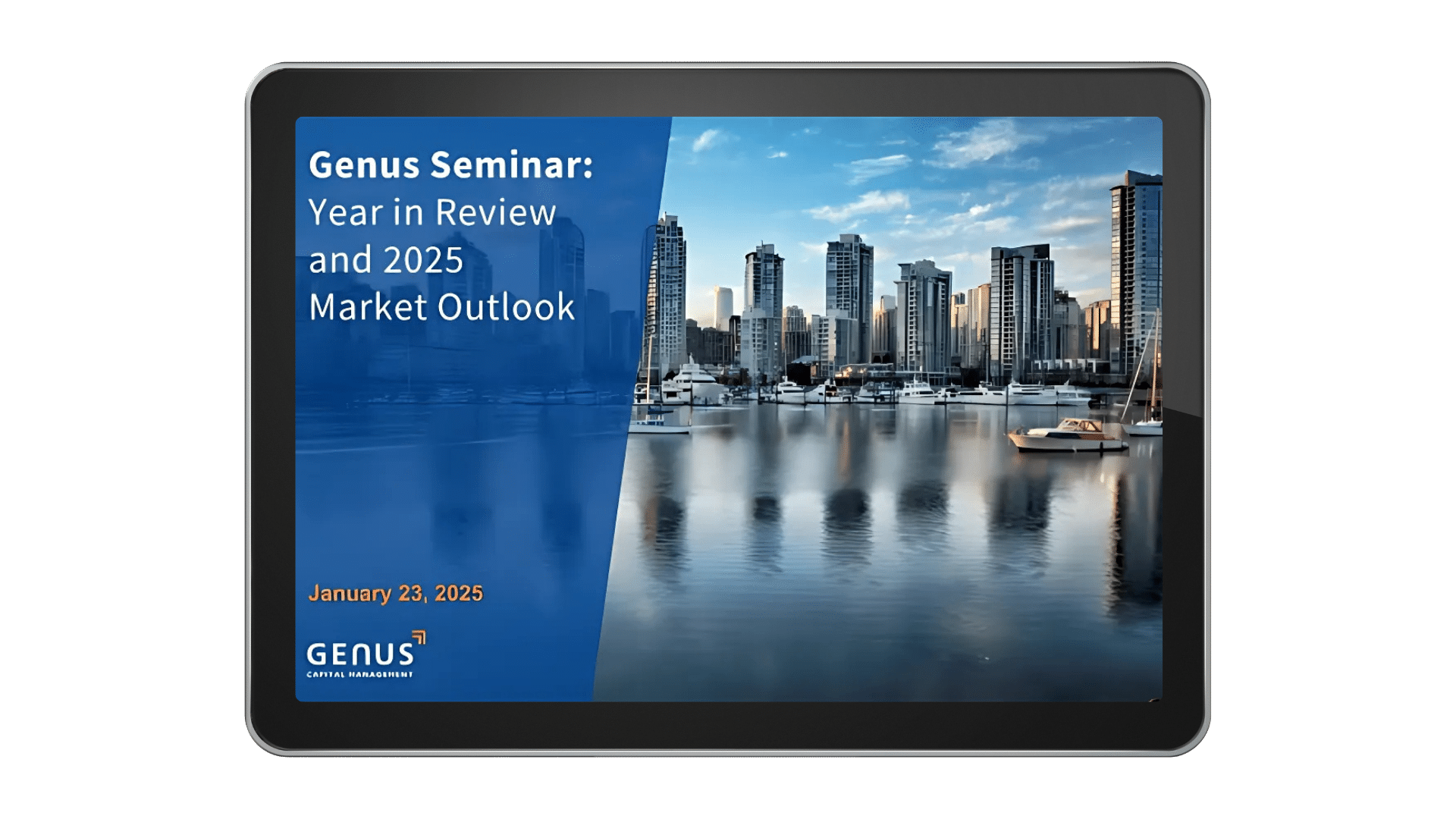It’s no understatement to say the landscape for ESG and impact investing has dramatically changed.
Thanks to U.S. policy shifts and broad political backlash against ESG, responsible and sustainable funds have not only seen a significant decrease in investments, even the vocabulary around these funds is changing, says James Dick, Senior Sustainable Investment Associate at Genus. And it’s happening in Canada, too. “One Canadian asset manager removed ESG from the title of their fund in response to the U.S. administration’s policies – and threats,” Dick says.
Last year saw asset managers in the U.S. and Europe wind down hundreds of ESG funds. And since then, literally every big bank in Canada has withdrawn from the United Nations’ Net-Zero Banking Alliance, a coalition established to promote climate action in the financial sector. “There’s a belief that the current U.S. administration has significantly increased the risks of firms that run funds that follow ESG investing themes,” Dick says. “So banks, in order to protect themselves in the largest market – the U.S. – have chosen to change the titles of their funds.”
With all of these changes, it might seem like ESG investing is on the decline, and particularly now, as stock markets tumble, ESG and impact investors might find themselves questioning the value of their responsible investments.
But we’ve got good news.
ESG investing isn’t going away, and is predicted to continue growing over the next decade. And many ESG investors are staying the course – buoyed by the knowledge that their investments are needed now more than ever. One example? “One of the UK’s largest pension funds took $35 billion from State Street (an American asset manager) and invested it into organizations with a genuine focus on ESG principles,” Dick says.
Committed ESG investors not only have an opportunity to double-down on their values, they can also step in to fill gaps left by the changes in policy and direction by the biggest players. Shifting the way we think about value – and thinking more holistically about the nature of returns – opens the door to the opportunities today’s environment offers ESG investors. And there are many.
Creating long-term impact

What happens week to week, month to month, and even year to year in the markets and in economic policy should never derail your personal investing objectives – or change your values. And we always talk to our clients about investing for the long-term.
That means focusing on personal goals such as building retirement savings and family wealth, or creating a legacy for the next generation. But it also means considering the long-term impact of your investments more externally.
Many of our clients have engaged in redefining what wealth means to them – and that can include creating positive change in the world by screening out companies doing harm, or actively investing in those that are doing good, such as companies aligned with the UN’s Sustainable Development Goals.
These investing strategies are inherently about a broader kind of long-term impact – the kind that can create a world we want future generations to inherit. “We’re investing to have this money 40 years from now,” Dick says. “So why aren’t we adjusting to investing in companies that will be here in 40 years, or business models that will be here?”
Filling gaps in impactful industries

As the U.S. cuts budgets and funding for government departments and initiatives, funds for research, development and growth in sectors such as health care and renewable energy will increasingly need to come from private investors. “The Biden administration believed the government needed to fill in this gap with renewable energy,” Dick says, “so they provided trillions of dollars to that space. Now we won’t see that as much going forward, so it’s important to find ways to invest capital to fill in those gaps – both in the U.S. and more globally. The private sector really has to step up and create that impact.”
Dick notes that these funding gaps will create new investment opportunities. “The current U.S. government wants to see the private sector doing more,” he says. “It is vital that firms are able to step up and reduce the impact of a smaller public sector to drive innovations that support environmental and social goals.” This means opportunities for investors to step up, too.
Tapping into new growth opportunities

Many investors look at market corrections as money lost. But if you’re investing for the long term, it’s also a chance to consider the opportunities for long-term growth. And right now, they’re everywhere – including in ESG and impact investments. The recent market correction means there are buying opportunities of highly impactful firms with significant opportunities for growth,” Dick says.
The material goal of ESG investing is to reduce a portfolio’s long-term risk, and ESG investing can be a great way to find long-term winners. But ultimately, current U.S. economic policy is focused on driving long-term growth, Dicks says. “The Trump Administration’s policies are centered on reducing the federal deficit, leading to lower interest rates, and lowering taxes and decreasing regulatory burdens – measures intended to stimulate private sector growth and sustain broader economic expansion.”
While ESG and impact investing may currently feel a bit topsy-turvy, the reality is, we’ve been here before – and we’ve come out stronger. During Trump’s first term, sustainably invested assets under management increased by 42 percent between 2018 and 2020 – from $12 trillion to $17.1 trillion.
There’s no reason to believe the opportunities to make a positive difference won’t continue to grow. And making an impact that goes beyond financial returns is a great reason to stay the course.
To determine if impact investing aligns with your financial goals, speak with a qualified advisor. Get started today with our values-based investment services.
Like all investment strategies, ESG and impact investing involve market and sector-specific risks. Past performance is not indicative of future results, and returns are not guaranteed. Investors should consider their financial goals, risk tolerance, and consult a financial professional before investing.
References:
Bloomberg News. (2025, March 3). Why ESG faces backlash and its future under Trump 2.0. BNN Bloomberg. https://www.bnnbloomberg.ca/investing/2025/03/03/why-esg-faces-backlash-and-its-future-under-trump-20/
Schwartzkopff, F. (2024, October 24). Hundreds of ESG funds are being wound down, Morningstar says. BNN Bloomberg. https://www.bnnbloomberg.ca/business/2024/10/24/hundreds-of-esg-funds-are-being-wound-down-morningstar-says/
Gonzales, F. (2025, February 3). Major bank exits Net-Zero Banking Alliance, completing Canadian banks’ withdrawal. Benefits and Pensions Monitor. https://www.benefitsandpensionsmonitor.com/news/industry-news/major-bank-exits-net-zero-banking-alliance-completing-canadian-banks-withdrawal/391017
- Ltd, S. I. P. (2025, February 21). ESG investing market to reach USD 130,880 billion by 2032 | SNS Insider. GlobeNewswire News Room. https://www.globenewswire.com/news-release/2025/02/21/3030525/0/en/ESG-Investing-Market-to-Reach-USD-130-880-Billion-by-2032-SNS-Insider.html
- Jessen, J. (2025, March 3). Why State Street lost US$35bn to Amundi & Invesco over ESG. Sustainability Magazine. https://sustainabilitymag.com/articles/why-state-street-lost-us-35bn-to-amundi-invesco-over-esg
- Iacurci, G. (2025, March 31). ‘Game over’ for ESG investing due to Trump backlash? Analysts say no. CNBC. https://www.cnbc.com/2025/03/31/trumps-backlash-isnt-game-over-for-esg-investing.html
- Nason, D. (2020, December 21). “Sustainable investing” is surging, accounting for 33% of total U.S. assets under management. CNBC. https://www.cnbc.com/2020/12/21/sustainable-investing-accounts-for-33percent-of-total-us-assets-under-management.html











